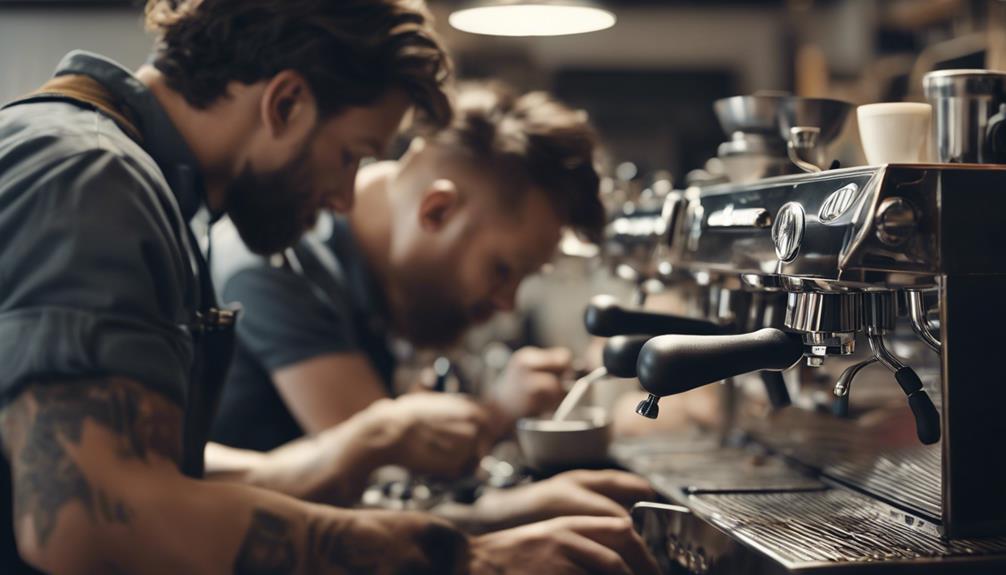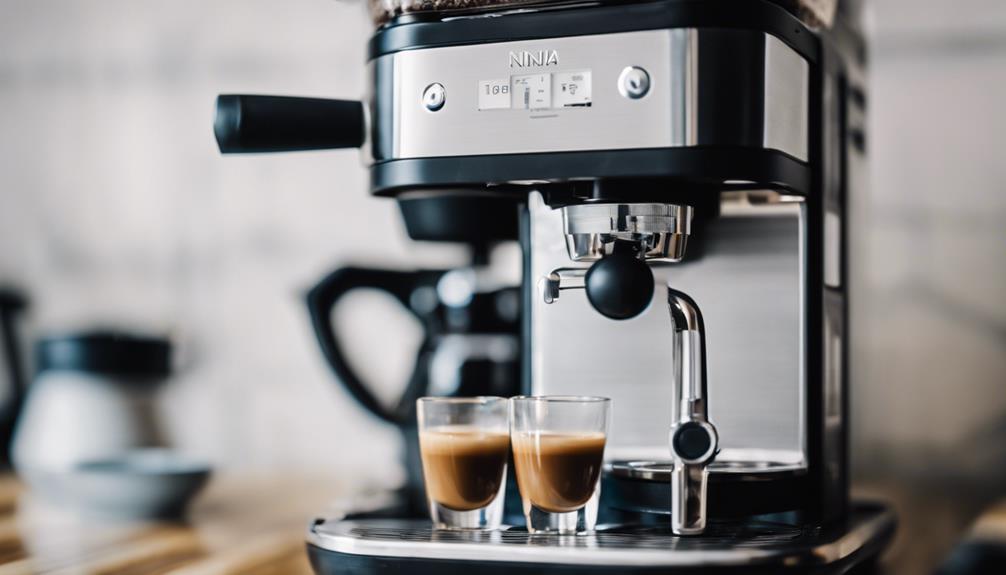When searching for the top 10 espresso machine repair shops, look for skilled technicians with excellent Yelp ratings. They will identify problems, provide upkeep, and use quality parts for long-lasting results. Quick turnaround times with repair warranties are available. You can count on reliable services with prompt replies and authentic parts for optimal performance. Experienced technicians who specialize in fixing various brands are known for their outstanding service. Trusted repair centers offer warranties, clear communication, and affordable rates. Select from a range of choices based on customer reviews and available services. Delve deeper to discover more about the expertise and dependability of these espresso machine repair shops.
Key Takeaways
- Top-rated technicians with 4.5+ stars on Yelp.
- Quick turnaround times with same-day service.
- High-quality parts used for longevity.
- Warranties offered on repair work.
- Exceptional customer service and expertise.
Expert Espresso Machine Repairs
When seeking expert espresso machine repairs, look for repair places with average ratings of 4.5 stars or higher on Yelp. These top-rated repair shops have garnered praise for their exceptional service and expertise in fixing espresso machines.
Customers often highlight the proficiency of the technicians who work on diagnosing issues, performing maintenance, and providing cleaning services for these intricate machines. One of the standout features of these repair centers is their quick turnaround times, with many offering same-day or next-day service to get your beloved espresso machine back up and running in no time.
Furthermore, these expert repair places are known for using high-quality parts in their repairs, ensuring the longevity and peak performance of your espresso machine. To add to their credibility, many of these top repair shops also offer warranties on their repair work, giving you peace of mind that your machine is in good hands.
Keep an eye out for these reputable establishments when in need of professional espresso machine repairs.
Reliable Espresso Machine Services

Seek out reliable espresso machine services at these top-rated repair places with an average customer rating of 4.5 stars or higher on Yelp.
These repair shops are known for their dedication to quality, offering warranties on their work to guarantee your satisfaction. With quick turnaround times, most repairs are completed within 1-2 days, minimizing your downtime without your beloved espresso machine.
By using genuine manufacturer parts, these repair places assure the peak performance of your machine, giving you peace of mind that it will function like new. Customers consistently praise the knowledgeable and friendly staff at these establishments, making your service experience pleasant and hassle-free.
When searching for reliable espresso machine services, consider these top-rated repair places that not only meet but exceed customer expectations with their exceptional service and expertise.
Top-rated Espresso Machine Technicians

Highly acclaimed for their exceptional skills and customer service, the top-rated espresso machine technicians boast an impressive average rating of 4.9 stars on Yelp.
Customers rave about their quick response times and efficient repair services, often accompanied by warranties that offer peace of mind.
These technicians have garnered praise for their expertise in repairing a variety of espresso machine brands, showcasing their in-depth knowledge in the field.
Many reviews highlight the excellent customer service provided by these technicians, emphasizing their dedication to ensuring customer satisfaction and imparting valuable insights into espresso machine maintenance.
With a track record of consistently high ratings and positive feedback, these top-rated espresso machine technicians have solidified their reputation as reliable and skilled professionals in the industry.
If you're in need of expert espresso machine repairs, considering the services of these top-rated technicians could be a wise choice for ensuring your machine is in good hands.
Trusted Espresso Machine Repair Shops

Out of the top 10 espresso machine repair shops identified for their consistent high ratings and positive reviews on Yelp, you can trust the expertise and professionalism of the technicians at these reputable establishments. When your espresso machine needs fixing, consider these trusted repair shops:
- Quick turnaround times and affordable pricing for repairs guarantee minimal disruption to your coffee routine.
- The use of genuine parts by these top-rated repair shops ensures quality and reliability in every repair.
- Warranties provided on services offer peace of mind knowing that your machine is covered post-repair.
- Excellent customer service and clear communication from the staff make the repair process smooth and transparent for you.
- Customers have praised the skill and knowledge of the technicians at these repair shops, highlighting their ability to diagnose and fix issues effectively.
Espresso Machine Maintenance Specialists

Espresso machine maintenance specialists listed on Yelp offer expert repair services for a variety of espresso machine brands. These specialists have earned high ratings from satisfied customers, with numerous positive reviews praising their prompt and effective repairs.
By utilizing Yelp, individuals can easily locate and contact espresso machine maintenance specialists in their vicinity. Businesses featured on Yelp as espresso machine maintenance specialists have the opportunity to showcase their skills and services to a broad audience seeking quality repairs.
Customers can make informed decisions by relying on the reviews on Yelp to select the best espresso machine maintenance specialist suited to their specific needs. Whether it's routine maintenance or addressing more complex issues, these specialists are equipped to handle a range of espresso machine problems efficiently and reliably.
Trusting in the expertise of these maintenance specialists can ensure that your espresso machine continues to brew that perfect cup of coffee for years to come.
Professional Espresso Machine Diagnostics

When diagnosing espresso machines, technicians conduct a thorough inspection to identify issues accurately.
They utilize specialized tools to assess electrical, mechanical, and performance-related problems to guarantee a detailed diagnosis.
This process helps determine the root cause of malfunctions, enabling efficient and effective repair solutions.
Diagnostic Process Overview
During professional espresso machine diagnostics, technicians conduct a thorough inspection of the machine's key components to identify any issues accurately. This process is vital for determining the root cause of the problems and guaranteeing a precise repair plan.
Here is an overview of the diagnostic process:
- Inspecting the water system to check for proper flow and pressure.
- Evaluating the boiler to make sure it reaches and maintains the correct temperature.
- Testing the pump to verify consistent pressure levels for brewing.
- Examining the group heads for any blockages or wear that may affect espresso quality.
- Using specialized tools to assess pressure, temperature, and brewing consistency for a detailed evaluation.
Common Repair Issues
Identifying common repair issues through professional espresso machine diagnostics is essential for guaranteeing peak performance and longevity. Trained technicians utilize specialized tools to uncover problems such as clogged filters, faulty heating elements, or pump malfunctions.
By conducting thorough inspections of internal components, these experts can pinpoint the root cause of performance issues accurately. Regular maintenance and professional diagnostics play a vital role in preventing costly repairs and extending the lifespan of your espresso machine.
Additionally, expert technicians can provide valuable maintenance tips and recommend suitable replacement parts based on diagnostic results to ensure peak functionality. Investing in professional espresso machine diagnostics not only resolves current issues efficiently but also helps in maintaining the overall health of your machine for years to come.
Trusting in the expertise of skilled technicians is key to keeping your espresso machine running smoothly and consistently delivering delicious brews.
Repair Cost Estimation
Professional espresso machine diagnostics for repair cost estimation typically involve utilizing specialized tools and equipment to accurately diagnose issues, with costs ranging from $50 to $150 depending on complexity.
When you take your espresso machine for repair cost estimation, here's what you can expect:
- Experienced technicians will use advanced tools to pinpoint the exact problems in your espresso machine.
- The diagnostic process will provide you with a detailed breakdown of the issues discovered and the repairs needed.
- Transparent pricing will be offered, ensuring you understand the costs upfront before committing to any repairs.
- Accurate diagnostics help you plan your budget effectively for the repair work required.
- By investing in professional repair cost estimation, you can avoid unexpected expenses and make informed decisions about your espresso machine's repairs.
Espresso Machine Troubleshooting Experts

For expert troubleshooting of your espresso machine issues, rely on the highly-rated professionals on Yelp. These experts have an average rating of 4.5 stars, showcasing their excellence in diagnosing and resolving espresso machine problems.
Whether you're facing brewing issues, water leaks, or electrical malfunctions, these specialists offer a wide range of repair services to meet your needs.
Customers consistently praise the expertise and professionalism of espresso machine troubleshooting experts on Yelp, highlighting their quick and efficient service that minimizes machine downtime. Additionally, many users mention the affordability and reliability of the repair services provided by these experts.
Espresso Machine Parts Replacement Services

When experiencing issues with your espresso machine, consider exploring the espresso machine parts replacement services offered by various repair places to guarantee peak performance. Here are some key points to keep in mind:
- Wide range of parts: Repair places typically offer replacement services for various components such as filters, gaskets, frothers, and portafilters.
- Expert technicians: Trained professionals at these repair centers can accurately identify and replace faulty parts to ensure your machine operates at its best.
- Genuine parts: It's advisable to opt for genuine replacement parts recommended by the repair places to maintain the quality and longevity of your espresso machine.
- Quick turnaround: Reputable repair places often provide swift turnaround times for parts replacement services, minimizing downtime for your machine.
- Brand compatibility: Ensure that the repair place you choose offers parts replacements for your specific espresso machine brand and model to guarantee compatibility.
Espresso Machine Repair Near You

Looking for espresso machine repair near you? Check out nearby repair options on platforms like Yelp for quick espresso fixes.
Positive user reviews can point you to top repair places in your area, where businesses engage with customers to showcase their expertise.
Nearby Repair Options
Explore the espresso machine repair options available near your location for convenient and efficient service. Here are some nearby repair options to explore:
- Espresso Machine Specialists: A dedicated repair shop known for fixing various brands like Breville, De'Longhi, and Nespresso machines.
- Affordable Pricing: Repair costs typically range from $50 to $150, depending on the repair complexity.
- Quick Turnaround: Expect fast service with same-day or next-day repairs for minor issues.
- High Customer Ratings: Enjoy reliable service based on Yelp reviews, with an average rating of 4.5 stars out of 5.
- Variety of Services: These repair shops offer a range of services beyond just fixing espresso machines, ensuring thorough assistance for your needs.
When selecting a repair shop, take into account factors like cost, turnaround time, and customer feedback to make an informed decision that meets your espresso machine repair needs effectively.
Quick Espresso Fixes
If your espresso machine is in need of quick fixes, consider the nearby repair options for efficient and convenient service. Espresso machine repair shops specialize in addressing common issues such as clogged filters, faulty pumps, and malfunctioning steam wands. Their professional technicians are well-equipped to diagnose and repair a wide range of problems across various espresso machine brands and models.
Most espresso machine repair shops offer on-site services or convenient pickup and delivery options to ensure a smooth experience for their customers. These repair services typically encompass cleaning, maintenance, part replacements, and thorough troubleshooting to guarantee top machine performance.
Choosing quick espresso fixes from reputable repair places can greatly extend the lifespan of your espresso machine while preserving the quality of your coffee. By entrusting your machine to experienced professionals, you can enjoy your favorite espresso beverages with peace of mind knowing that any issues will be promptly and effectively resolved.
Espresso Machine Service Centers

Espresso machine service centers play a crucial role in maintaining and repairing espresso machines for peak performance. Here are some key points about these service centers:
- Specialize in repairing and maintaining espresso machines to guarantee top-notch performance.
- Have trained technicians who can diagnose and fix various issues with espresso machines.
- Offer warranty repairs and use genuine parts for quality repairs.
- Allow customers to schedule appointments or drop off their machines for prompt repairs.
- Provide cleaning and maintenance services to prolong the lifespan of espresso machines.
Espresso machine service centers are essential for keeping your beloved espresso maker running smoothly. Whether it's a simple fix or a more complex issue, these centers have the expertise and resources to get your machine back in top shape.
Don't hesitate to reach out to them for all your espresso machine repair and maintenance needs.
Frequently Asked Questions
How Much Does It Cost to Fix an Espresso Machine?
Fixing an espresso machine can cost between $50 to $300, depending on the repair needed. Basic fixes like gasket or steam wand replacements may be around $50 to $100.
For more complex issues like pump or heating element repairs, expect to pay between $150 to $300. Factor in labor costs of $50 to $100 per hour.
To get an accurate estimate, it's best to obtain a quote from a professional repair service.
Do Espresso Machines Need to Be Serviced?
To keep your espresso machine running smoothly, regular servicing is vital. Neglecting maintenance can lead to costly issues like clogs and leaks.
By following the manufacturer's recommendations and scheduling servicing every 6 to 12 months, you can prevent problems and extend the lifespan of your machine.
Professional servicing typically includes descaling, cleaning, parts inspection, and calibration.
Investing in maintenance now can save you from expensive repairs or needing to replace your espresso machine prematurely.
How Do You Troubleshoot an Espresso Machine?
To troubleshoot an espresso machine, start by checking the power source and cleaning the portafilter, filter basket, and group head.
Regular descaling can prevent clogs, and make sure the water reservoir is filled correctly.
If basic fixes don't work, refer to the manual or contact a professional repair service.
Proper maintenance and troubleshooting can help keep your espresso machine running smoothly and extend its lifespan.
How Much Does It Cost to Service a Commercial Coffee Machine?
Servicing a commercial coffee machine can cost between $100 to $500, depending on the repair needed. Routine maintenance typically falls in the range of $150 to $300 per visit.
Major repairs like replacing a boiler or pump can exceed $500. Costs vary based on the machine's brand, model, and age.
Regular maintenance is essential to prevent breakdowns and extend the equipment's lifespan.
Can PID Help Improve the Function of My Espresso Machine and Prevent the Need for Repairs?
Yes, you need PID for an espresso machine. A PID can help improve the functionality of your machine by providing precise temperature control, which can result in better extraction and consistency. This can prevent the need for costly repairs by ensuring that your machine operates efficiently and effectively.
Where Can I Get My Espresso Machine Repaired with a PID Installation?
If you’re looking for a place to repair your espresso machine and get a PID installation, look no further! Our expert technicians can handle all your espresso machine needs, including installing a pid for espresso machines. Trust us to get your machine back up and running perfectly.
Conclusion
To sum it up, finding the right espresso machine repair place can be a piece of cake with our list of top 10 options. From expert technicians to reliable services, you'll be in good hands no matter which shop you choose.
So, don't cry over spilled milk – take your espresso machine to one of these trusted repair centers and get back to enjoying your favorite brew in no time.









